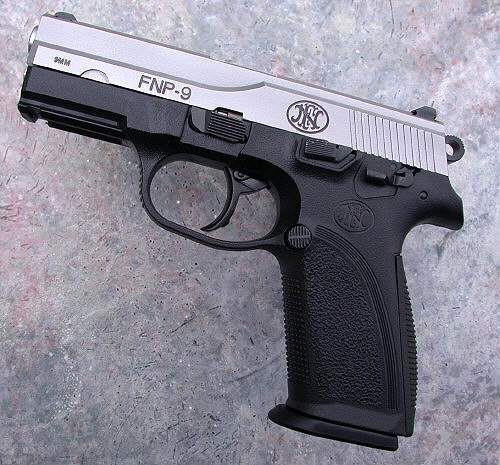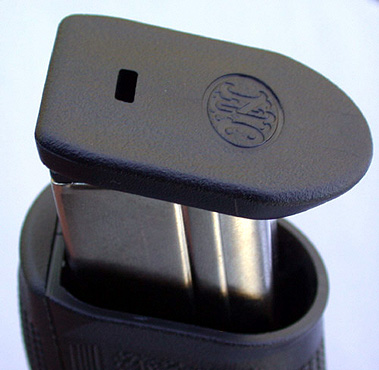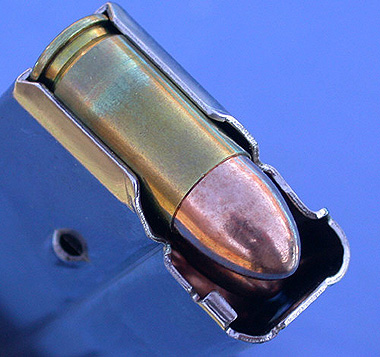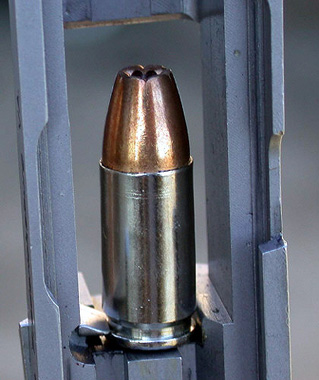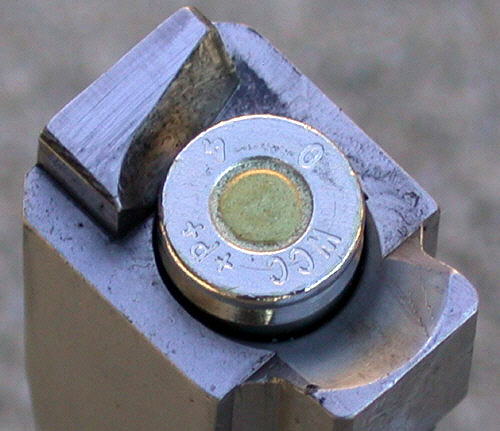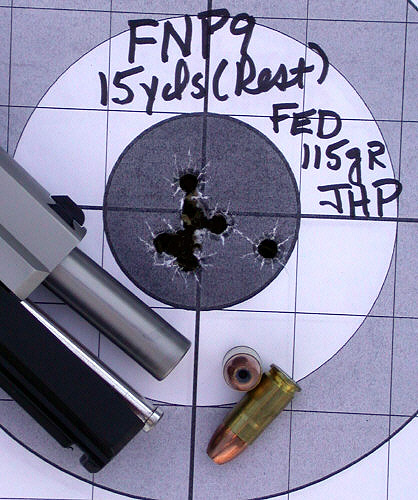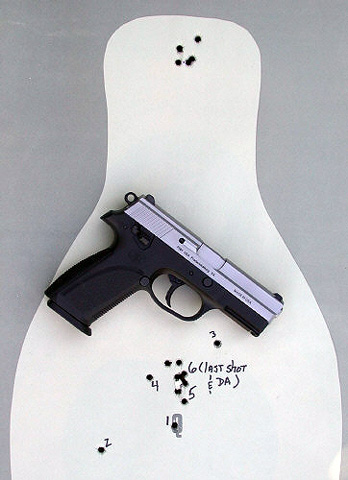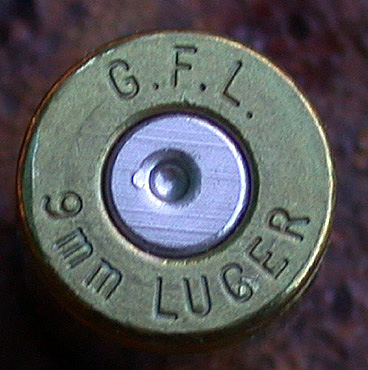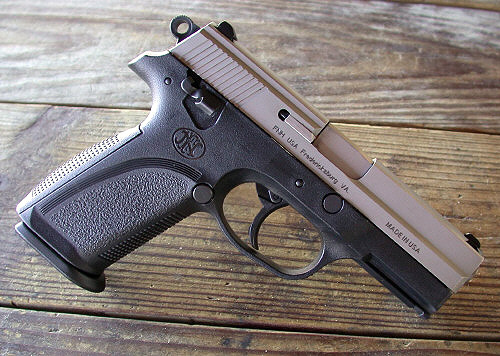9mm vs. 38 Special: The Cartridges & the Guns
By Stephen Camp
While reading comparisons of the pros and cons of the pocket 380 versus the snub 38 I noted a reader suggesting a comparison of the pocket nines to the popular 38 compact revolvers. Other projects and responsibilities prevented my starting work on such an article immediately, but during the interim I decided that it might be better to compare not only the pocket nines to the pocket 38 Specials, but the service size handguns in both calibers as well. I will do the best I can in this regard with the firearms that I have available.
I also recalled reading that some state that the 38 Special and the 9mm are equivalent in terms of "stopping power". We'll take a look at some actual average velocities from both calibers from different length barrels and see what the truth actually is and how much is just hot air. Bullet weights will be as close as possible between the two calibers for a more meaningful comparison.
Also included will be reasons for my own selections between the two and why. These are not necessarily recommendations or even suggestions, just my own admittedly subjective observations. The reader can decide if he or she agrees and make his or her own decisions. I have little use for the "only-my-way-is-right" approach since I don't have the wisdom necessary to make all decisions for all people. What is "right" for me doesn't necessarily mean that it is right for anyone else. Let me add that after many years of trying about everything that was available, I made my own decisions. I listened to others in many cases and others I ignored, but in the end I wound up with what works for me. Please let me suggest that this approach be considered in your own decisions.

Often compared are 380 and 38 Special handguns as exemplified by the Bersa Thunder and Colt Agent shown above. The merits of the revolver vs. semiautomatic are often mentioned, but sometimes the debate centers only on the ballistic capabilities of the cartridges. I have approached the subject myself in the articles linked here for those who might have interest:
http://i5.photobucket.com/albums/y171/hipowersandhandguns/NorincoRust2.jpg
http://www.hipowersandhandguns.com/Comparisonof9x18mmMakarovetc.htm

This article's focus is the 9x19mm compared to the .38 Special not only in different loads and bullet weights, but from different barrel lengths for both. Pictured are "new" vs. "old" technology cartridges. The 9mm shown is Winchester's 127-gr. +P+ Ranger, a round considered one of the best in that caliber. The .38 Special is a Remington 158-gr. LSWCHP +P, an example of the "old" approach. Often referred to as either the "FBI" or "Chicago Load", many still consider it to be one of the best. (It is sometimes erroneously called the "Treasury Load". The Treasury Load incorporated a 110-gr. JHP at high velocity.)
Also discussed will be such things as magazine/cylinder capacity, ease of reloading, as well as other advantages and disadvantages of the handgun types encountered when choosing between the revolver and the semiautomatic. Felt recoil and practical accuracy will also be covered.

We will look at the compact nines such as the Glock 26 and compare them to the typical J-frame 1 7/8" .38 as well as the 3" and 4" barrel revolvers. Larger 9mm pistols will also be compared with respect to actual chronographed ballistic performance as well as handling characteristics.
When comparing barrel lengths on revolvers versus automatics, we find that with the latter we must take the chamber into account. Revolver barrels are measured from the muzzle to the face of the forcing cone. For example, an S&W Model 638 has a listed barrel length of 1 7/8" and the bullet actually does actually accelerate that distance. A Colt 9mm Commander has a listed barrel length of 4 1/4", but the 9x19mm case length is right at 0.75". This is because the chamber is included in the barrel length. Therefore, the actual effective barrel length is 3.5" in this example. Simply deducting case length is not exact. Some bullets engage the rifling quicker than others due to their shape, but deducting 3/4" is close enough for general discussions.
.38 Special: Like the 9mm, this cartridge hit the ground circa 1902. It was intended to improve the ballistic performance of the .38 Long Colt which tossed a 150-gr. nonexpanding lead bullet at roughly 770 ft/sec. This had proven ineffective against Moro warriors during our conflict with them from 1898 to 1901. Because of this the military pressed the .45 Colt back into service. In normal trim, the .38 Special would achieve roughly 850 ft/sec with a 158-gr. lead bullet from a 6" barrel. I leave how much of an improvement this actually was to the reader. It should also be noted that the service rifle at the time (.30-40 Krag) had some failures to "stop" the determined Moros. I suspect that the .45 Colt did too, but can certainly see a larger diameter nonexpanding bullet at 250-255-grains at roughly 900 ft/sec offering more potential as a "stopper" than the .38 Long Colt. It was the .38 Long Colt that "failed" against the Moros, not the .38 Special. (Frankly, I suspect that its performance would not have been significantly better with the ammunition available at that time.)
The .38 Special has a maximum length overall of 1.550" and case length is 1.155". SAAMI pressure for the standard pressure load is 17000 PSI. The +P has a ceiling of 20000 PSI. There are no SAAMI specifications for +P+, but there are some +P+ rounds available in this caliber. Bullet diameter is usually .356 to 0.358".
I have not researched the history of this cartridge. Some say that it was originally offered in black powder and the switch to smokeless necessarily involved keeping pressures low because the existing guns couldn't handle much more pressure safely. Others say that it was simply because of the quality of some .38 Special revolvers. I actually do not know the definitive answer as I don't shoot this round in poorly made revolvers and am not a real "historian" of either handguns or ammunition.
Regardless of the real reason, the safe working pressures for this round are among the lowest and this is the reason that the physically larger .38 Special cartridges' velocities are usually considerably lower than those of the high-pressure 9mm round.
The .38 Special served this nation's police from federal agents to town marshals for the biggest part of the last century. I carried a 4" S&W Model 10 as my first duty gun when a fledging police officer. The caliber is still popular today, but more so in the compact snubs than the full service type revolvers that used to fill lawmen's holsters. It has a reputation for accuracy. I'm not sure how much of that is due to the fact that its recoil is mild from the service weapon and most police matches were fired with lighter loaded target wadcutters. I do know that some of the tightest groups from any service guns I've ever seen or shot were done with the 4" S&W Model 10 Heavy Barrel and Model 15 Combat Masterpiece. The popular bull barrel match guns were scary accurate in competent hands.
Seen more often today in snub nose form, the guns still possess more intrinsic mechanical accuracy than most of us can make use of, but are harder to shoot accurately. This is due to shorter sight radius and the lighter weight of the guns themselves. The lighter snub may be much easier to carry than its heavier counterpart, but this works against its practical accuracy. However, these lightweight revolvers are certainly accurate enough for close-in defensive shooting in practiced hands. It has been my observation that most folks opine that these guns are harder to shoot accurately than many of the .380 automatics and believe that this is a major reason that the .380 also remains popular. Unless shooting the super small 9mm pistols, felt recoil is usually not mentioned as being "bad", but the sharp recoil of the hot-loaded Airweight (or lighter) snub often is.

The J-frame Model 638 is smaller and lighter than the all-steel K-frame 3" Model 64. Weighing less and with usually smaller stocks felt recoil is greater than with the heavier/larger revolver even if the same ammunition or load is being used. One is easier to hide, has shorter sight radius, and has greater felt recoil. The other is slightly harder to conceal, larger, weighs more, but is almost always easier for most people to shoot well. Its felt recoil is not usually objectionable even though it will normally produce higher velocities than the 1 7/8" J-frame.
At one time, the full-size .38 Special revolver was routinely seen in police holsters either by choice or regulation and not surprisingly, in more than a few dresser drawers for home defense. Some were snubs, but I'll bet many more were 4" versions just like those toted by US police. Today I'll wager that the 3" K-frames and lightweight J-frame versions are the more popular.

The S&W Model 10 Heavy Barrel was once very commonly used by police officers. Most were seen in square butt configuration. My first duty revolver was just such a gun. The Model 10 pictured was made more recently and with the round butt frame. The duty size .38 revolver is not as popular as in decades past. For those interested, here are some thoughts on that topic:
http://www.hipowersandhandguns.com/Humble%2038%20Special.htm
As is true with most things, there are both strong and weak points to the more compact .38 snubs versus the larger revolvers in that caliber. Where the J-frame or its equivalent is easier to conceal, it can be harder to shoot accurately and felt recoil is greater. The service style revolvers are easier to shoot accurately, have less felt recoil and greater velocity when the same ammo is used in it or the snub. The snub nose may have equivalent potential accuracy, but its practical accuracy can be less if not used in skilled hands.
The same arguments hold true for the 9mm semiautomatics, but it does seem that there are fewer complaints concerning felt recoil with the smaller nines than with the lightweight .38 Special snub nose revolvers.
Let's take a look at some average velocities from the .38 Special guns. Figures listed are based on ten shots fired ten feet from the chronograph. Where possible, the same load's velocity is shown from different length barrels. Not all listed loads have such commonality. In some instances, the average velocity will be only from one revolver and barrel length.
.38 Special Average Velocities
| Revolver | Load | Bbl (in.) | Velocity (ft/sec) |
| S&W M638 | Corbon 110-gr. DPX* | 1 7/8 | 1077 |
| S&W M64 | Corbon 110-gr. DPX | 3 | 1118 |
| S&W M10 | Corbon 110-gr. DPX | 4 | 1122 |
| S&W M642 | Corbon 115-gr. JHP +P+* | 1 7/8 | 1188 |
| S&W M64 | Corbon 115-gr. JHP +P+ | 3 | 1349 |
| S&W M10 | Corbon 115-gr. JHP +P+ | 4 | 1412 |
| S&W M642 | Federal Nyclad 125-gr. HP* | 1 7/8 | 836 |
| S&W M10 | Federal Nyclad 125-gr. HP | 4 | 938 |
| S&W M642 | PMC Starfire 125-gr. JHP +P | 1 7/8 | 859 |
| S&W M64 | Magtech 125-gr. JHP +P** | 3 | 927 |
| S&W M10 | Magtech 125-gr. JHP +P | 4 | 960 |
| S&W M64 | Federal 147-gr. HS +P+*** | 3 | 911 |
| S&W M10 | Federal 147-gr. HS +P+ | 4 | 917 |
| S&W M642 | S&B 148-gr. Wadcutter | 1 7/8 | 541 |
| S&W M10 | S&B 148-gr. Wadcutter | 4 | 607 |
| S&W M642 | Remington 158-gr. LSWCHP +P | 1 7/8 | 800 |
| S&W M64 | Remington 158-gr. LSWCHP +P | 3 | 883 |
| S&W M10 | Remington 158-gr. LSWCHP +P | 4 | 888 |
*Discontinued load
**Guardian Gold line of JHP
***Law Enforcement Restricted HydraShok load
In no case did we see a bullet over 125 grains break 1000 ft/sec. The Corbon 110-gr. DPX (standard pressure load) did by over 100 ft/sec, but this bullet has been a problem for me in some snub revolvers. Approximately 20% were not stable and did not strike targets at 15 yards straight on. (It should be noted that all of the standard pressure DPX loads worked perfectly from 3 and 4" barrels. This load is no longer available and has been replaced with a +P version. Perhaps this will boost velocities just enough to get perfect stabilization in the 1 7/8" barrels.)
Without question, the speed demon of this bunch was the discontinued super-hot +P+ Corbon 115-gr. JHP. This load used 9mm 115-gr. Sierra Power Jacket Hollow Points loaded in .38 Special cases. This stuff is hot. Though ejection was fine in each revolver I tried it in, I personally do not use it in my J-frame .38 Specials. I think it's just too much and will either have excessive flame cutting, frame stretching, or crack the forcing cone. Felt recoil is sharp and memorable from the little aluminum frame snubs, but it is not bad from the K-frame revolvers.
Generally speaking, we can expect velocities from about 850 to 950 ft/sec from most 110 and 125-gr. loads in .38 Special depending upon barrel length and whether the load is standard pressure or +P.
(For what it's worth, I continue to use the Remington 158-gr. LSWCHP +P in my .38 Specials regardless of barrel length. The reasons are pretty simple. It has a good reputation among those who have used it in fights and I find that the fixed revolver sights are usually pretty well "on" for this load. It is reported to have less than stellar expansion when fired into 10% ballistic gelatin after passing through 4 layers of denim, but this "problem" goes away in the 3 and 4" barrels. It appears that the 800-840 ft/sec range it travels from my snubs is right on the ballistic edge of reliability through barriers. At speeds closer to 900 ft/sec this load reportedly works fine in such tests. I leave it to the reader to decide how much merit the "denim test" does or does not have.)
Note also the average speeds for the 148-gr. wadcutter load. Other brands chronographed very little faster. These keg-shaped bullets are sometimes recommended for self-protection. They do have reduced recoil to be sure, but I'll take my chances with something a bit faster.
Now let's take a gander at the 9mm cartridge.
9x19mm (AKA 9mm, 9mm Luger, 9mm Parabellum): This compact, high-pressure cartridge hit the ground in 1902 and was adopted by the German navy in 1904 with the army following suit in 1904. Since that time, the 9mm has been the military sidearm round for more than a few countries. It fought on both sides during WWII in the guise of the Browning Hi Power and has seen its share of bloodletting for all of the last century and into this one.
SAAMI pressure ratings for the 9mm are 35,000 PSI for standard and 38,500 for +P. There are no designated SAAMI specs for +P+ that I can find. For that reason, if a person opts for +P+ ammunition I'd go with one of the "known" ammunition makers such as Winchester, Remington, Federal, or Corbon.
Maximum cartridge LOA is 1.169" and case length should not exceed 0.754".
Though its popularity in the US has grown significantly, the 9mm has never been as popular here as in Europe. In this country I believe it has usually played second fiddle to the .45 ACP, a strong favorite amongst defense-oriented shooters. I also believe that in its better loads, the .45 is more potent than 9mm, but when the latter is being used with its best loads, I'm not convinced the difference is staggering and maybe not significant. Because no two gunshot wounds or people are exactly alike, it is very difficult to quantify "stopping power."
In service style pistols the 9mm is a very easy round to shoot well. In the more compact guns, felt recoil does increase depending upon the size and weight of the pistol. Some opine that because of the locked breech used in 9mm pistols, felt recoil is not as sharp as with a similarly sized .38 Special firing warm loads. I tend to agree but understand that my most "compact" 9mm is a Glock 26. Firing the polymer frame Kahr has not resulted in any unfavorable memories concerning recoil.
Just as the increasing number of states allowing for some form of licensed concealed carry of handguns by private citizens, compact 9mm handguns are continually being produced and sold because there is a demand. In this, the compact nine mirrors the popularity of the long popular .38 snub.
Though somewhat eclipsed by service semiautomatics in .40 S&W, .357 SIG, and the ever-popular .45 ACP, the 9mm in a full-size gun remains quite popular. I own several and have no intentions of selling them.


The Browning Mk III represents the traditional single-action service pistol while the Glock 26 represents the move toward more compact 9mm pistols. In the picture on the right we can see the same G26 compared to the traditional S&W J-frame .38 Special. The Rohrbaugh R9 is a more compact 9mm as are examples from KelTec, Kahr, and others. For those interested in the Rohrbaugh R9, an article on this gun was contributed and can be read via the link below:
http://www.hipowersandhandguns.com/R9.htm
Though it is by no means limited, there are probably more ammo selections in 9mm than .38 Special and bulk ammunition for range use is definitely less costly in 9mm.

In this picture we see the K-frame S&W Model 10 snub with 2" barrel and the Model 042 with its slightly shorter 1 7/8" tube. The all-steel K-frame is significantly easier to shoot if recoil is a problem. The lightweight compact J-frames are easier to conceal and carry but the cost is increased felt recoil. My own subjective observation is that felt recoil in the steel frame Model 10 snub is very similar to that of the Glock 26 or steel-framed Kahr K9.
I do not own any 9mm revolvers so velocity comparisons cannot be with exactly the same barrel lengths. I lost interest in the 9mm revolver when I shot some and experienced difficulty in extracting cases when +P loads were used. I am told that this does not exist in all 9mm revolvers. I've shot only two and it did in both of those. One was an S&W, the other a Ruger.
Earlier we described the difference in the way revolver and automatic barrels are measured. When listing 9mm velocities, I will give the pistol's actual bbl length in inches and what I call its "effective bbl length." This is simply the total barrel length less 0.75". It gives a more accurate understanding of the speeds attained after passing through that length of rifled barrel. (Data from the Rohrbaugh is taken from the article linked above.)
9mm Average Velocities
| Pistol | Load | Bbl Length (in.) | EBL (in.) | Velocity (ft/sec) |
| Rohrbaugh R9 | Fiocchi 115-gr. FMJ | 3 | 2.25 | 978 |
| Glock 26 | Fiocchi 115-gr. FMJ | 3.46 | 2.71 | 1180 |
| Rohrbaugh R9 | Win. USA 115-gr. FMJ | 3 | 2.25 | 1072 |
| Glock 26 | Win. USA 115-gr. FMJ | 3.46 | 2.71 | 1097 |
| Rohrbaugh R9 | Win. 115-gr. STHP | 3 | 2.25 | 1047 |
| Rohrbaugh R9 | Federal 124-gr. HS | 3 | 2.25 | 1054 |
| Glock 26 | Corbon 115-gr. DPX+P | 3.46 | 2.71 | 1181 |
| SIG-Sauer P225 | Corbon 115-gr. DPX+P | 3.86 | 3.11 | 1163 |
| Browning Mk III | Corbon 115-gr. DPX+P | 4.66 | 3.91 | 1244 |
| Browning Mk III | Corbon 115-gr. JHP +P | 4.66 | 3.91 | 1411 |
| Glock 26 | Corbon 125-gr. JHP +P | 3.46 | 2.71 | 1188 |
| Browning Mk III | Corbon 125-gr. JHP +P | 4.66 | 2.71 | 1312 |
| Glock 26 | Win. 127-gr. +P+ | 3.46 | 2.71 | 1246 |
| SIG-Sauer P225 | Win. 127-gr. +P+ | 3.86 | 3.11 | 1215 |
| Browning Mk III | Win. 127-gr. +P+ | 4.66 | 3.91 | 1269 |
| SIG-Sauer P225 | Remington 147-gr GS | 3.86 | 3.11 | 942 |
| Browning Mk III | Remington 147-gr GS | 4.66 | 3.91 | 1033 |
I do not have access to all guns and all loads so comparisons will have to be approximate and not as exact as I would prefer. Nonetheless I believe that at least some "ballpark" observations can be made. In most cases, bullet weights between 9mm and .38 will not be the same, but I'll get them as close as I can. With that in mind, let's compare some of the loads.
First, let us take a look at the Rohrbaugh R9 compared to the J-frame snub. The R9 has an effective barrel length of 2 1/4" compared to the actual 1 7/8" bbl of the little revolver.
With Corbon 110-gr. DPX, the J-frame averaged 1077 ft/sec while the R9 obtains the almost identical 1072 ft/sec with Winchester 115-gr. USA FMJ. Using standard pressure Federal Nyclad 125-gr. HP, the snub got 836 ft/sec. With the standard pressure Speer 124-gr. Gold Dot, the Rohrbaugh averaged 1054 ft/sec, a significant increase of 218 ft/sec. Looking at the super hot Corbon 115-gr. .38 Special +P+, we see the snub getting an incredible 1188 ft/sec! The R9's owner fired no really warm loads, so I have nothing to really compare with, but this is a really stepping out for a snub. It is an exception to the rule and a load that I'm leery of in the J-frame revolvers. Likewise, I don't have anything in 9mm in the shortest bbl length to compare to the 158-gr. load.
Moving up to the Model 64, recall that it has a 3" barrel. That's fairly close to the 3.11" effective barrel length of the SIG-Sauer P225. From the revolver's 3" tube, Corbon 110-gr. DPX averaged 1118 ft/sec. From the P225, Federal 115-gr. JHP got 1177 ft/sec, an increase of 59 ft/sec. The Model 64 attained a very fast 1349 ft/sec with the Corbon 115-gr. +P+ round compared to 1337 ft/sec when the same bullet was fired at +P (not +P+) from the 3.11" barrel of the P225. The difference is only 12 ft/sec; I think we will agree that for all intents and purposes, the Corbon +P+ .38 from the Model 64 and the +P from the P225 are equivalent. The Magtech 125-gr. Guardian Gold JHP +P attained a more typical 927 ft/sec from the 3" revolver compared to the 1081 ft/sec for Hornady's factory "Custom" XTP from the P225, a standard pressure load! The 9mm beat the .38 this time by 154 ft/sec and w/o going to +P. From the Glock 26 with its shorter effective bbl length of 2.71", the Corbon 125-gr. +P averaged 1188 ft/sec. This beat the 3" Model 64 by 261 ft/sec. Moving into +P+, the 9mm tossed the excellent Winchester 127-gr. Ranger Talon JHP at 1215 ft/sec from the P225 and 1246 ft/sec from the Glock 26. This amounts to the 9mm beating the .38 by 288 and 319 ft/sec, respectively. With the 147-gr. +P+ Federal HydraShok load from the 3" wheel gun, we see an average speed of 911 ft/sec. From the near equivalent 3.11" effective bbl length of the P225, Remington 147-gr. Golden Saber attained 942 ft/sec. This difference is only 31 ft/sec and probably meaningless. The point is that this was a maximum effort +P+ .38 load and standard pressure 9mm.
Going to the 4" service length Model 10, we see that the standard pressure Corbon 110-gr. DPX reached 1122 ft/sec. The Browning Mk III 9mm Hi Power has an effective bbl length of 3.91" and tossed the 115-gr. Federal "Classic" JHP at 1177 ft/sec, winning by a mere 55 ft/sec. The super hot and discontinued .38 Corbon 115-gr. +P+ sizzled from the 4" at 1412 ft/sec. From the slightly shorter effective bbl length of the Hi Power, the 9mm +P from the same company and using the same bullet averaged exactly 1 ft/sec less. Magtech 125-gr. Guardian Gold +P reached 960 ft/sec from the 4" revolver bbl. The standard pressure version of Speer's 124-gr. Gold Dot hit 1109 ft/sec from the Hi Power, a gain of 149 ft/sec. The +P version reached 1200 ft/sec besting the .38 by 240 ft/sec. The hot Corbon 125-gr. JHP +P screamed across the chronograph screens at 1312 ft/sec, decisively beating the .38 by 352 ft/sec. Moving into the 147-gr. weight common to both calibers, the 4" Model 10 averaged 917 ft/sec with the +P+ load. From the Browning, the 147-gr. Golden Saber hit 1033 ft/sec. This beat the 4" revolver by 116 ft/sec and at standard pressures.
What we are seeing is actually greater case capacity but lower operating pressures (.38 Special) versus higher operating pressures but smaller case capacity (9mm). I have little doubt that if the ammunition makers had the financial incentive to do the research into better .38 Special bullets and more efficient powders for that cartridge's capacity and working pressures, we would see some really nice gains in this grand old cartridge. We are seeing at least some attempts now. CCI/Speer recently introduced a "short barrel" line of ammunition and this includes .38 Special. That load is +P and the bullet is a Gold Dot weighing 135-gr. Initial reports indicate that it moves about 860 ft/sec from a snub to about 975 ft/sec from a 4". Folks testing it in 10% ballistic gelatin are reporting that it expands even after passing through external barriers such as denim. I have not personally tested any of this company's newest short barrel loads, but will in the near future if at all possible. The Gold Dot bullet design has proven to be a reliable performer and is a favorite for many shooters. For those wanting the highest velocities for a given bullet weight, try Corbon. I have found that most of the time, actual average velocities at least equal and generally exceed their published nominal speeds.
So what's the bottom line? Is the .38 Special just as "powerful" as 9mm? In my observation, the answer is "not usually." There are some exceptional loads that do show equivalence with the usually faster 9mm. In general, I think it's safe to say that a +P .38 Special can sometimes be equivalent to a standard pressure 9mm load in the same (or nearly the same) bullet weight. Usually the 9mm +P and +P+ will walk away from the .38 +P equivalent from the same or nearly equivalent barrel lengths.
So which is the best to carry? I will offer my own choices. As mentioned early on in this report, my decisions may not necessarily be the right one for another single solitary soul, but they work for me.
In the compact defensive handgun, my first choice remains the J-frame Airweight S&W and almost always the Model 642. My primary reason is that in my now tame lifestyle, I find this revolver to be most conveniently carried 24/7 in a pocket holster. Around the house and sometimes away, it may be my primary weapon. When carrying another handgun, it is still present. If you think this option might be right for you, I add this caveat: You absolutely must practice with it if you are to be effective. The steel frame versions are a bit easier to shoot because the extra weight absorbs a bit more of the recoil, but for me the Airweight aluminum frame revolver works better for pocket carry. These are not as light as their titanium successors, but neither are they heavy. More importantly, the Airweight version can be used with lead bullets. With the even lighter titanium guns, one is restricted to jacketed ammunition only. Their lighter weight allows lead bullets to unseat themselves in recoil. This has never been a problem with any of my aluminum framed Airweights.
If interested in using/carrying a J-frame, these articles might be of interest:
http://www.hipowersandhandguns.com/Making%20J%20Frame%20Work.htm
http://www.hipowersandhandguns.com/Feedingthe38Snub.htm
http://www.hipowersandhandguns.com/Getting%20a%20Grip%20on%20J%20Frames.htm
If considering a mid-size gun, I have grown really fond of the 3" bbl. revolvers in either .38 Special or .357 magnum. For me, they are significantly easier to shoot accurately at speed than the 1 7/8" snubs or even the all-steel 2" K-frames. That extra inch of sight radius is significant for me. Frankly, I don't do much better with the 4" gun compared to the 3"! This surprised me, but such has been my experiences with them on several range sessions to check that very point.

When I carry a revolver as a belt gun, it is very often this Ruger SP101 w/3 1/16" barrel. The well-worn Model 642 and at least one speed loader carrying Remington 158-gr. LSWCHP +P back it up. Both guns hold 5 shots and the J-frame speed loader for the S&W snub fits both guns. My normal first six shots in the little Ruger .357 are Remington 125-gr. Golden Sabers. This is a mid-power .357 load, but one that I can control at speed for accurate hits. These average 1189 ft/sec. (That sounds very close to the 9mm Winchester 127-g. +P+ 9mm at 1215 ft/sec fired from the SIG-Sauer P225 with its effective bbl length of 3.11".)
Were I in gang territory or expecting to deal with more than a couple or three miscreants, my choices might be considerably different, but for most situations, I am confident and satisfied with the SP101 backed up by the Model 642 and one extra reload. At the same time I am not going to argue that perhaps a better combination might be the Glock 26 backed up by the snub. That the Glock holds 10 + 1 before reloading compared to the SP101's five is a strong point in favor of the little autoloader.


For most of us, the revolver will require longer times to reload than the autoloader given equivalent amounts of practice. This is certainly an important consideration, but is it the overriding one for you in your particular situation?

For a defense-minded shooter, this Glock 17 with expanding ammunition might be a prime choice in 9mm. It holds 17 + 1 shots and gets high velocity with most 9mm rounds. My mother's gun is a Colt Police Positive loaded with standard velocity 125-gr. Federal Nyclads. She is not a shooter, but she "understands" this revolver and can handle its mild recoil. My wife's personal revolver is an S&W Model 65 LadySmith. It is loaded with Remington 158-gr. LSWCHP +P. She is not a shooting enthusiast and this combination is what she understands and prefers to the many handguns I've had her shoot.
It should come as no surprise that when carrying a 9mm belt gun, my first choice is almost always the Browning Mk III 9mm. Like the single-action 1911, it is a vintage design that some call "obsolete." For me it is a handgun that lets me put 9mm holes where I want them quickly. Earlier I stated that I believed .45 ACP to be a more potent stopper in some loads. That does not mean I believe the 9mm to be anybody's weak sister. With my loads of choice in the Hi Power, I do not feel ballistically undergunned. I can hit with this pistol and accurate hits are required regardless of handgun caliber in my view. The reader's choice in 9mm sidearms for belt carry might be very different from mine. Fine…if that's what works for that reader.
For me there are other deciding factors in my choice of carry guns. If required, I could carry a 4" .38 Special revolver with my choice of loads and feel fine, but I'd prefer a 9mm weapon of equivalent size or a .45 auto. In the most compact versions of either the .38 revolver or the 9mm auto, I cast my lot with the revolver. I find them very secure in pocket holsters since most of their weight is forward and much less in the butt of the gun, unlike the automatic. In the compact Glock 26 I see intellectually that it is a superior choice to the 3" revolver with its lighter trigger pull and significantly greater number of shots between reloads. I still simply prefer the mid-size wheel gun most of the time, but in service size pistols, I much prefer the 9mm Hi Power to any .38 revolver.
I am hoping that this report has accomplished a couple of things. I have tried to show how the .38 and 9mm stack up ballistically and that perhaps there are other considerations besides "power" that enter our individual equations for the ideal carry gun in either of these calibers. Generally speaking, I do believe that 9mm can have a ballistic edge over the .38 Special most of the time, but also remain convinced that the revolver round can strike a telling blow with good ammunition and in practiced hands. I had much rather have a .38 revolver that I could shoot accurately at speed than a 9mm automatic I was not comfortable with or lived in constant fear of it malfunctioning even if it never had. (Some folks simply do not trust automatics. I believe that faith in one's personal defensive arm is essential. The revolver certainly can malfunction, but the perception of "six (or five) for sure" remains reality for some people. The simplicity of the double-action wheel gun is also a plus for persons not inclined to practice much at the firing range.)
The snub .38 with 158-gr. +P lead hollow points is as "low" on the "power ladder" as I choose to go. The 3 and 4" .38 revolvers with the same ammunition move up from that bottom a good deal and from either of these two barrel lengths I believe the .38 Special to be a capable performer with that load. (I'm sure that there are others, but right now, I have more experience and trust in the "old technology" 158-gr. +P LSWCHP.)
While I believe the 9mm to be a more effective defense caliber with several loads, I am not saying that the .38 cannot be effective. As with many calibers there is some ballistic overlapping between the two. For most of us, either caliber can be a very decisive and viable anti-personnel round. Power, penetration, expansion, etc are important aspects of defensive handgunning, but so is trust in one's weapon, personal preferences, and being able to get the shots.
If you considering a defensive handgun in either .38 Special or 9mm, shoot as many of each as you are able if possible. Get some good training and attain the skill level necessary for you to get accurate hits quickly. Consider your own personal lifestyle/job situation and then make the decision that is right for you.
************************************************************************************************
BIBLICAL INFORMATION:
![]()
|
 JERUSALEM (AFP) - Jewish extremists opposed to Israel's looming pullout from the Gaza Strip have dipped into ancient ritual to put an Aramaic death curse on Prime Minister Ariel Sharon, a news website revealed.
JERUSALEM (AFP) - Jewish extremists opposed to Israel's looming pullout from the Gaza Strip have dipped into ancient ritual to put an Aramaic death curse on Prime Minister Ariel Sharon, a news website revealed.In a cemetery ceremony presided over by a rabbi, around 20 radicals held a "pulsa dinura", which means rod of fire in Aramaic, imploring God to curse a believed sinner, said the online edition of the Yediot Aharonot.
The ancient Jewish rite was presided over by rabbi Yossef Dayan at dawn on Friday in the ancient cemetery of Rosh Pina, in the northern Galilee region.
As befits tradition, only those who are married, meaning no widowers or divorcees, people aged over 40 and the bearded were able to attend the event, Dayan was quoted as saying.
The group urged "the angels of destruction" to kill Sharon, participants said, stressing that a human assassination attempt on the prime minister was "futile" given his massive security protection.
The ceremony took place near the grave of Shlomo Ben Yossef, a member of the ultra-nationalist Jewish movement Beitar, who was hanged in 1938 under British mandate Palestine for taking part in an attempted attack on an Arab bus.
Baruch Ben Yossef, one of the participants, said the spot was ideal.
"He is Sharons antitheses. Ben Yossef sacrificed his soul for the people of Israel, while Sharon is robbing the nation. We hope the Lord will take him from us," he was quoted as saying by the website.
Far-right Israeli activists also held a "pulsa dinura" to pray for the death of Yitzhak Rabin in 1995, a few days before the prime minister was assassinated by a Jewish extremist for trying to make peace with the Palestinians.
***************************************************************************
PREMEDITATED MERGER
3rd SPP summit shrouded in secrecy
Bush to interrupt Texas vacation to join Mexican, Canadian leaders
Posted: August 13, 2007
1:00 a.m. Eastern
By Jerome R. Corsi
© 2007 WorldNetDaily.com
President Bush will interrupt his summer vacation in Crawford, Texas, next week to attend the third summit meeting of the Security and Prosperity Partnership of North America, or SPP, slated for Aug. 20 and 21 in Montebello, Quebec, at the five-star Fairmont Le Chateau Montebello resort.
 President Bush to join leaders of Mexico and Canada at the Fairmont Le Chateau Montebello resort in Quebec next week for the third summit meeting of the Security and Prosperity Partnership of North America |
Bush will meet with Mexico's President Felipe Calderon and Canada's Prime Minister Stephen Harper at the event.
The meeting has been hidden in a cloud of secrecy until WND obtained from an Access to Information Act request a previously unreleased copy of a government report detailing agenda plans for the third SPP summit.
According to WND reports, as many as 10,000 protesters are expected to be in Quebec to oppose the meeting.
The Royal Canadian Mounted Police, Canada's national police force, and the Sûreté du Québec, the state police, plan to maintain a 25-kilometer protest-free zone around the Montebello resort where the meeting is to be held.
(Story continues below)
WND has reported that a multinational business agenda is driving this upcoming SPP summit according to the heavily redacted document obtained from the Canadian government.
The memo clearly states at center stage in the Montebello SPP summit will be recommendations by the North American Competitiveness Council, regarding promoting North American competitiveness for multinational corporations through "integrating" and "harmonizing" regulations between Mexico, Canada and the U.S.
The council, an executive group composed of 10 top multinational corporations from each of the three SPP countries, was constituted under the auspices of the U.S. Department of Commerce to provide guidance to the 20 SPP working groups of U.S., Mexican, and Canadian bureaucrats.
WND has also reported that President Bush will discuss at the summit a plan to send U.S. military assistance to Mexico to assist Mexico's military and civilian law enforcement agencies to combat Mexican narco-criminals and drug lords.
The leaders at the end of their summit are expected to make a statement on U.S. military aid to Mexico, provided their discussions have reached a point of agreement and conclusion.
At issue are questions of how the U.S. military can limit involvement to equipment and training, and how U.S. and Mexican officials can be certain the corruption common to Mexico's drug war does not subvert their effort or provide sophisticated equipment and technology that ends up in the hands of the drug kingpins.
WND has also reported the Montebello SPP summit will create a coordinating body to prepare for the North American response to an outbreak of avian or pandemic influenza.
The three leaders also plan to create a coordinating body on emergency management similar to that set up for avian or pandemic flu.
WND previously reported on National Security Presidential Directive No. 51 and Homeland Security Presidential Directive No. 20, which allocate to the office of the president the authority to direct all levels of government in any event the president declares to be a national emergency.
WND also has previously reported that under SPP, the military of the U.S. and Canada are turning USNORTHCOM and Canada Command into domestic military command structures, with authority extending to Mexico, even though Mexico has not formally joined with the current U.S. – Canadian USNORTHCOM/Canada Command structure.
WND has also learned the Montebello SPP summit will include discussion of a proposal to provide U.S. military assistance to the government of Mexico to help Mexico's military combat narco-trafficking in Mexico.
The SPP website, maintained by the U.S. Department of Commerce, lists a "2005 Report to Leaders" dated June 2005 and a "2006 Report to Leaders" dated August 2006, which document over 250 memoranda of understanding and other agreements that have been signed by the SPP working groups.
Most of these SPP memoranda of understanding and other agreements cannot be found on the SPP website or elsewhere on the Internet published in their entirety.
No comparable "2007 Report to Leaders" has yet been published on the SPP website.
WND has applied for press credentials to attend the Montebello SPP summit to report on the proceedings.
****************************************************************************************************************
Middle East
|
|
